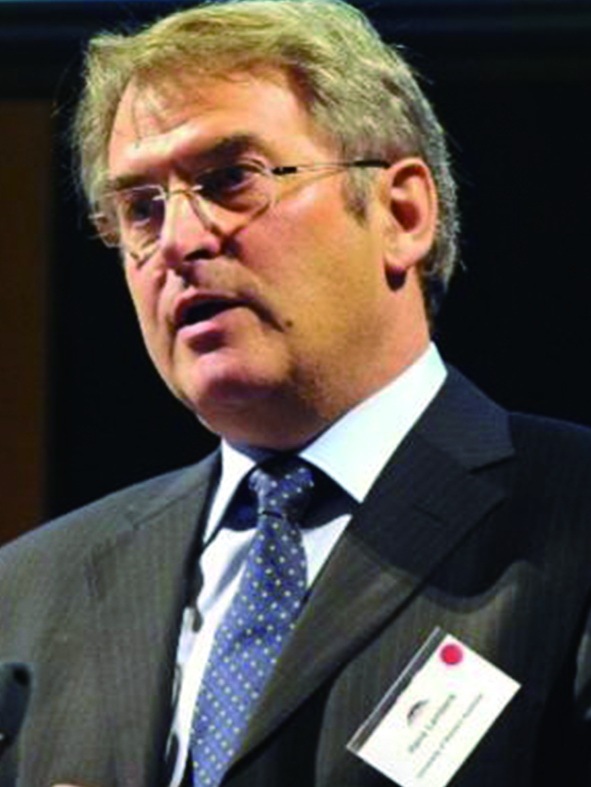检索范围:
排序: 展示方式:
SHANG Weijuan, WANG Daxin, WANG Xiaolin
《化学科学与工程前沿(英文)》 2007年 第1卷 第2期 页码 208-215 doi: 10.1007/s11705-007-0038-0
关键词: above-mentioned TMS characterization electrostatic semiempirical
The main achievements in the past 24 years and the prospects of mechanism research in China
ZOU Hui-jun, ZHANG Long, ZHANG Qing
《机械工程前沿(英文)》 2006年 第1卷 第3期 页码 249-259 doi: 10.1007/s11465-006-0038-7
关键词: above-mentioned developed Generally reformation breakthrough research
《农业科学与工程前沿(英文)》 2022年 第9卷 第2期 页码 167-169 doi: 10.15302/J-FASE-2022446
Intensive agriculture, characterized by strong reliance on excessive amount of external agrochemical inputs in simplified cropping systems has contributed successfully to feeding an increasing number of humans, but at the expense of severe resource and environmental costs. Consequently, the Earth is facing multifaceted challenges, including increasing food demand both in quantity and quality, global warming associated with extreme weather events, soil degradation and depletion of natural resources. To address some of these challenges, we have developed this Special Issue on Sustainable Crop and Pasture Systems for Frontiers of Agricultural Sciences and Engineering (FASE). The issue addresses the research frontiers of two main themes: (1) aboveground-belowground ecological and physiological mechanisms, processes and ecosystem functions; and (2) the synergies and trade-offs between multiple ecosystem services in sustainable crop and pasture systems. There are 10 articles in this Special Issue including review and research articles with contributions from Australia, China, France, the Netherlands, and the UK. The contributors are all highly-regarded scientists devoted to studies on mechanisms and applications of sustainable crop and pasture systems.
Sustainable crop and pasture systems have a potential to enhance the synergies in multiple ecosystem services, consisting of higher food production, lower environmental impacts and climate change mitigation. To innovate sustainable cropping systems requires deeper and comprehensive understanding of mechanisms underlying above- and belowground interactions. Hans Lambers and Wen-Feng Cong emphasized the importance of diversifying crop species or genotypes with complementary or facilitative functional traits. This will mediate key ecosystem processes related to water, carbon and nutrients, contributing to higher resource-use efficiency and enhancing synergies in ecosystem services ( https://doi.org/10.15302/J-FASE-2022444). Root functional traits such as root exudates are pivotal in nutrient mobilization, either directly mobilizing plant nutrients in the soil or indirectly so via modifications of the soil microbiome. Cathryn A. O'Sullivan and coworkers reported a novel role of root exudates from canola in inhibiting nitrification in soils. They found that these root exudates (called biological nitrogen (N) inhibitors) can significantly reduce nitrification rates of both Nitrosospira multiformis cultures and native nitrifying communities in soil. This would reduce nitrate losses, but increase plant N uptake and microbial N immobilization, subsequently benefiting the following cereal crops through mineralization of this organic N pool ( https://doi.org/10.15302/J-FASE-2021421). Jonathan Storkey and Andrew J. Macdonald used the longest-lasting grassland biodiversity experiment in the world to examine the relationships between plant functional traits and ecosystem services. They reported a strong trade-off between plots with high productivity, N inputs and soil organic carbon and plots with a large number of plant species with contrasting nutrient-acquisition strategies. An increasing proportion of forbs with greater longevity and lower leaf dry matter content can partly mitigate the trade-offs between plant diversity and productivity ( https://doi.org/10.15302/J-FASE-2021438).
John A. Raven further explored synergies or trade-offs of ecosystem services regulated by above- and belowground interactions, mainly functioning through energy, material and information pathways. Solar energy is the key driver for photosynthesis and transpiration, modulating the flow of water and nutrients in soils moving aboveground and the flow of carbohydrates feeding belowground biota. Information transfer can be through hydraulic, electrical and chemical signaling, regulating plant development, abiotic and biotic damage and resource excess and limitation ( https://doi.org/10.15302/J-FASE-2021433).
Timothy S. George and coauthors highlighted the importance of harnessing biodiversity principles and physiological mechanisms in diversified cropping systems to achieve agricultural sustainability. They demonstrate that crop diversification combined with optimized management such as minimum tillage and reduced fertilizer inputs can improve soil quality, promoting soil biotic activities and associated functions. This will reduce the reliance on agrochemical inputs and environmental impacts, and increase climatic resilience ( https://doi.org/10.15302/J-FASE-2021437). Ruqiang Zhang and coworkers applied the One Health concept to design healthy dairy farms. They employed a wide range of soil and plant diversity measures such as intercropping, crop rotation and flower strips at both field and landscape scales to reduce the inputs of fertilizers, pesticides as well as soil compaction caused by heavy machines. The biodiversity-based solutions can help dairy farmers maintain a healthy eco-environment, while producing high-quality milk ( https://doi.org/10.15302/J-FASE-2022445). Emily C. Cooledge and her colleagues show that introducing multispecies leys with perennial legumes and other forbs into arable rotations will achieve multiple ecosystem benefits. This occurs mainly in three ways—return of livestock manure, permanent soil cover and less disturbance of soil—which promote soil food web interactions and soil aggregate stability, subsequently sequestering more carbon in soils ( https://doi.org/10.15302/J-FASE-2021439). Ting Luo and coauthors used the sugarcane cropping system in China as an example and analyzed the current challenges and problems and proposed a wide range of crop, soil and input management practices such as crop rotation, strategic tillage and optimized nutrient management to achieve sustainable sugarcane cropping systems ( https://doi.org/10.15302/J-FASE-2022442).
Focusing on the multi-objective assessment of different cropping systems, Léa Kervroëdan and coworkers assessed the agronomic and environmental impacts of food, feed and mixed (food, feed and biogas) cropping systems. They found that mixed cropping systems had a greater potential of bioenergy production and agronomic performance, but also higher greenhouse gas emissions. This warrants long-term examination of whether short-term higher greenhouse gas emissions can be offset by long-term soil carbon sequestration in this system ( https://doi.org/10.15302/J-FASE-2021435). Jeroen C. J. Groot and Xiaolin Yang applied a new mathematical approach of evolutionary multi-objective optimization to 30 cropping systems practiced on the North China Plain with the aim of overcoming the trade-offs between revenues, energy and nutrient supply and groundwater depletion at a regional level. This approach allows national or regional policymakers to plan growing area of certain sustainable cropping systems ( https://doi.org/10.15302/J-FASE-2021434).
As the Guest Editors, we thank all authors and reviewers for their valuable contributions to this Special Issue on Sustainable Crop and Pasture Systems. We also thank the FASE editorial team for their professional support.

Dr. Wen-Feng Cong, Associate Professor at College of Resource and Environmental Sciences, China Agricultural University. He obtained his PhD at Wageningen University in the Netherlands and conducted postdoctoral research at Aarhus University in Denmark. His research focuses on understanding the mechanisms underlying the positive effects of crop, genotype and cropping system diversity on soil carbon sequestration and soil phosphorus utilization, and applying the ecological mechanisms to design sustainable diversified cropping systems. He is author of over 30 papers in peer-reviewed scientific journals, including Trends in Plant Science, Trends in Ecology & Evolution, and Global Change Biology. He is leading or participating in sustainable cropping systems related projects funded by the National Natural Science Foundation of China and the Chinese Academy of Engineering. He is acting as a member of the editorial board of Frontiers in Agronomyand Frontiers in Soil Science.

Dr. Hans Lambers, Emeritus Professor at the University of Western Australia and Distinguished Professor at College of Resource and Environmental Sciences, China Agricultural University. He obtained his PhD at the University of Groningen in the Netherlands and conducted postdoctoral research in Australia and the Netherlands, before taking up a position of Professor of Plant Ecophysiology at Utrecht University in the Netherlands and then Professor of Plant Biology and Ecology at the University of Western Australia in Australia. His research focuses on understanding plant–soil interactions and plant nutrition, with an emphasis on Australian plants and crop legumes. He is author of over 550 papers in peer-reviewed scientific journals, including Annual Review of Plant Biology,Trends in Plant Science, Trends in Ecology & Evolution, New Phytologist, Plant and Soil,Global Change Biology, andNature Plants. He is leading or participating in projects on plant nutrition funded by the Australian Research Council. He is the lead author of an influential textbook, Plant Physiological Ecology (1998, 2008, and 2019), Editor in Chief of Plant and Soil(1992–present), and Associate Editor in Chief ofFrontiers of Agricultural Sciences and Engineering
INTERACTIONS BETWEEN ABOVE AND BELOW GROUND PLANT STRUCTURES: MECHANISMS AND ECOSYSTEM SERVICES
《农业科学与工程前沿(英文)》 2022年 第9卷 第2期 页码 197-213 doi: 10.15302/J-FASE-2021433
Interactions between above and below ground parts of plants can be considered under the (overlapping) categories of energy, material and information. Solar energy powers photosynthesis and transpiration by above ground structures, and drives most water uptake through roots and supplies energy as organic matter to below ground parts, including diazotrophic symbionts and mycorrhizas. Material transfer occurs as water and dissolved soil-derived elements transport up the xylem, and a small fraction of water moving up the xylem with dissolved organic carbon and other solutes down the phloem. The cytosolic nature of sieve tubes accounts for at least some of the cycling of K, Mg and P down the phloem. NO3– assimilation of above ground parts requires organic N transport down phloem with, in some cases, organic anions related to shoot acid-base regulation. Long-distance information transfer is related development, biotic and abiotic damage, and above and below ground resource excess and limitation. Information transfer can involve hydraulic, electrical and chemical signaling, with their varying speeds of transmission and information content. Interaction of above and below ground plant parts is an important component of the ecosystem service of storing atmospheric CO2 as organic C in soil, a process that has decreased since the origin of agriculture.
关键词: aerenchyma / carbon accumulation / hormones / phloem / xylem
林秉南,周建军,张仁
《中国工程科学》 2000年 第2卷 第4期 页码 25-33
提出引海水5000~1 500m3/s在利津注入黄河冲刷河口。冲刷后,在利津将产生3.3~7.9m的水面跌差,可制止黄河河口延伸的溯源淤积作用上延,并诱发其上游产生溯源冲刷。估计可使艾山以下河道得到冲深。因挟沙海水的密度大于渤海环境水体的密度,咸浑水进入渤海时可形成异重流,将泥沙输去远方;而且断流期间河口还可能蚀退;因此引海水流量足够时,可使河口不外延或外延缓慢。从长远看,河口侵蚀基准面得到降低后,可以使黄河下游的淤积面均得到降低。这对缓解黄河下游河道持续淤高的局面和减少河口改道的风险都是有利的。
黄河下游额定冲沙水占黄河水资源总量很大比例,大量抽取淡水会增加下游的淤积。引海水冲刷河口,可 以增加河口地区从黄河抽取淡水的数量。这样抽取的淡水是冲沙水的一部分,不受用水分配额度的限制,对河 口地区的发展具有重要意义。引海水冲刷口门段,可向渤海注入大量咸浑水、有利于改进渤海的环境生态条件。 当然,引海水冲刷时须解决河道和引海水渠道的咸水外渗问题。
标题 作者 时间 类型 操作
Modeling of the separation performance of nanofiltration membranes and its role in the applications of nanofiltration technology in product separation processes
SHANG Weijuan, WANG Daxin, WANG Xiaolin
期刊论文
The main achievements in the past 24 years and the prospects of mechanism research in China
ZOU Hui-jun, ZHANG Long, ZHANG Qing
期刊论文
SUSTAINABLE CROP AND PASTURE SYSTEMS: FROM ABOVE- AND BELOWGROUND INTERACTIONS TO ECOSYSTEM MULTIFUNCTIONALITY
期刊论文
INTERACTIONS BETWEEN ABOVE AND BELOW GROUND PLANT STRUCTURES: MECHANISMS AND ECOSYSTEM SERVICES
期刊论文








